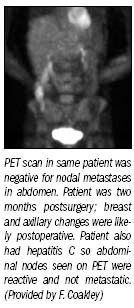Learn what you need to know about oncology imaging
Despite a complex array of tests for imaging the abdomen, there are really only three things that oncologists need to tell radiologists in order to get the most out of these imaging studies, according to Dr. Fergus V. Coakley, chief of abdominal imaging at the University of California, San Francisco.
Despite a complex array of tests for imaging the abdomen, there are really only three things that oncologists need to tell radiologists in order to get the most out of these imaging studies, according to Dr. Fergus V. Coakley, chief of abdominal imaging at the University of California, San Francisco.
“We need you to tell us the working diagnosis; what treatment the patient has had; and-the most critical-what is the question you want answered by this test? That's the most important one,” Coakley said during a presentation at American Society of Clinical Oncology (ASCO) 2009 in Orlando, FL.
“Is it to confirm the diagnosis? Evaluate the patient for surgery? Evaluate response to therapy? All of these things will influence the choice of test, how we do it, and how we interpret it,” Coakley said.
He was speaking at the education session sponsored jointly by ASCO and RSNA.
This exchange of clinical information between oncologist and radiologist is critical to achieve the best patient care, said Coakley, who is also a professor of radiology and urology and vice chair of clinical services at UCSF.
“We need to talk to each other. It is going to improve how you pick your tests, how they are performed, and how they are interpreted,” he said.
CHOICE OF TEST
PET/CT is a good test for evaluating extent of disease in patients who are surgical candidates. Coakley described the case of a 30-year-old woman with familial adenomatous polyposis who had undergone sigmoidectomy two months earlier for node-negative colon cancer. She had a new liver metastasis detected on CT and surgery was being considered.
This patient was a candidate for whole-body PET/CT to see whether there was extrahepatic disease, he said. Indeed, her scan showed that she actually had two extrahepatic sites of metastatic disease, which made her ineligible for surgery.
“This is a prime example of how whole-body PET/CT can really help you fully evaluate the true extent of disease in these presurgical patients,” he said.
A baseline PET scan can also be useful. Coakley discussed a patient with metastatic breast cancer in whom a new sclerotic focus in the spine (L1) developed. Most clinicians would assume that this was a progression of disease, he said. But in fact, the baseline PET scan showed metastasis that was occult on a CT scan.
“This is an example of healing by sclerosis and pseudoprogression, and is a good example of how a baseline PET can help you. I'm not sure you need to follow up these patients with PET, but I think a baseline PET gives you the best single-shot evaluation of disease extent,” he said.
It's also important to know which tests are not appropriate under which circumstances. For instance, PET has low sensitivity for brain metastases, so gadolinium-enhanced MRI may be a better option. PET also has low sensitivity for mucinous colorectal cancer.
“PET may also be negative after treatment,” Coakley said. “Oncologists tend to regard that as a false-negative, but that's debatable and the issue may be one of terminology.”
That tumor may be suppressed metabolically, but you could still have measurable residual disease on CT despite a totally negative PET scan, he said.
Finally, PET/CT should always be done with contrast.
“It is an abomination to do an expensive PET scan and then link it to a dull, dark CT scan and call that a nondiagnostic CT,” Coakley said.
However, there is a sizeable radiation dose associated with CT, which makes it less suitable for use in following up low-risk patients, such as those with testicular cancer or lymphoma, he said.
TEST TECHNIQUE
Once the appropriate test has been agreed on, the technique must be decided as well. Coakley cited an example of a 45-year-old patient with cirrhosis and a rising alpha-fetoprotein level. Would a standard portal venous phase CT scan be enough? Not in this case, because hepatocellular carcinoma is one of those tumors that is often hypervascular and seen best on the arterial phase, he said.

“One of the big questions when we do a CT scan is: are we going to do single-phase or multiphase? Most of the time, the single portal venous phase is perfectly adequate because most tumors are hypovascular,” he said.
But, as with hepatocellular carcinoma, there are other tumors, such as neuroendrocrine metastases and pancreatic adenocarcinoma, that are hypervascular and can be seen only on the arterial phase.
TEST INTERPRETATION
Coakley illustrated the importance of providing a complete clinical history to the radiologist with the case of a 64-year-old woman with breast cancer. On the basis of imaging studies, the report came back as a large breast mass with axillary and abdominal adenopathy, consistent with breast cancer and nodal metastases.
“On the face of it, that interpretation was justifiable-until you get the extra information,” he said. “She was two months postsurgery, so the breast and axillary changes were likely postoperative.”
GE HealthCare Debuts AI-Powered Cardiac CT Device at ACC Conference
April 1st 2025Featuring enhanced low-dose image quality with motion-free images, the Revolution Vibe CT system reportedly facilitates improved diagnostic clarity for patients with conditions ranging from in-stent restenosis to atrial fibrillation.
The Reading Room Podcast: Current Perspectives on the Updated Appropriate Use Criteria for Brain PET
March 18th 2025In a new podcast, Satoshi Minoshima, M.D., Ph.D., and James Williams, Ph.D., share their insights on the recently updated appropriate use criteria for amyloid PET and tau PET in patients with mild cognitive impairment.